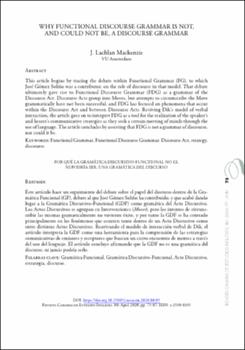Why Functional Discourse Grammar is Not, and Could Not Be, a Discourse Grammar
Autor
Lachlan Mackenzie, J.Fecha
2020Resumen
Este artículo hace un seguimiento del debate sobre el papel del discurso dentro de la Gramática Funcional (GF), debate al que José Gómez Soliño ha contribuido, y que acabó dando
lugar a la Gramática Discursivo-Funcional (GDF) como gramática del Acto Discursivo.
Los Actos Discursivos se agrupan en Intervenciones (Moves), pero los intentos de circunscribir las mismas gramaticalmente no tuvieron éxito, y por tanto la GDF se ha centrado
principalmente en los fenómenos que ocurren tanto dentro de un Acto Discursivo como
entre distintos Actos Discursivos. Reavivando el modelo de interacción verbal de Dik, el
artículo interpreta la GDF como una herramienta para la comprensión de las estrategias
comunicativas de emisores y receptores que buscan un cierto encuentro de mentes a través
del uso del lenguaje. El artículo concluye afirmando que la GDF no es una gramática del
discurso, ni jamás podría serlo. This article begins by tracing the debate within Functional Grammar (FG), to which
José Gómez Soliño was a contributor, on the role of discourse in that model. That debate
ultimately gave rise to Functional Discourse Grammar (FDG) as a grammar of the
Discourse Act. Discourse Acts group into Moves, but attempts to circumscribe the Move
grammatically have not been successful, and FDG has focused on phenomena that occur
within the Discourse Act and between Discourse Acts. Reviving Dik’s model of verbal
interaction, the article goes on to interpret FDG as a tool for the realization of the speaker’s
and hearer’s communicative strategies as they seek a certain meeting of minds through the
use of language. The article concludes by asserting that FDG is not a grammar of discourse,
nor could it be.





